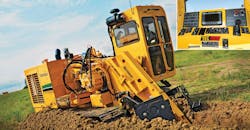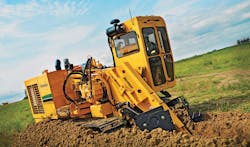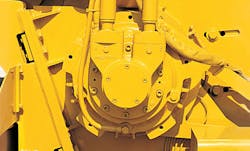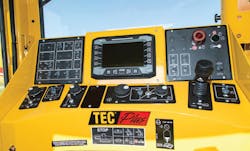Hydrostatic Trencher can Dig Automatically
Vermeer’s T-755 hydrostatic tracked trencher combines toughness with technology. The powerful machine is designed for digging in rock, cross-country trenching or working drainage and utility projects on roadways. The T-755 cuts trenches as deep as 10 ft and 14- to 36-in. wide at chain speeds of 397 to 724 ft/min. These operations and more are monitored and controlled by Vermeer’s Smarttec electronic control system for versatility and ease of operation. The system also records key functions for proactive maintenance and operator performance analysis. Its software provides real-time operator prompts based on operating conditions.
Vermeer’s T-755 hydrostatic trencher uses a low-speed, high-torque motor fed by two pumps to drive its trenching chain. Although it’s shown here cutting into dirt, it’s just as capable digging into rock using rotary, carbide-tipped cutters.
Traction and Trenching Circuits
The T-755’s dual-path hydrostatic drive, powered by a 275-hp @ 2,200-rpm diesel engine, uses a matching pump, hydraulic motor, and planetary transmission in a separate circuit for each track and is capable of full counter-rotation. A 4-pad pump drive box transmits torque and rotational speed to a pair of pumps that supply the traction and another pair powers the low-speed, high-torque trenching motor. Maximum transport speed for the 37.5-ton machine is 170 ft/min, with digging speeds from 0 to 91 fpm. Practical cutting speed ranges from 400 to 670 fpm, depending on the application and operating conditions. The machine’s service brakes also are hydrostatic, parking and emergency brakes are spring-applied, hydraulically-released.
But the T-755 really gets down to business with its digging chain with rotary, carbide-tipped cutters, which is powered by a single low-speed, high-torque hydraulic motor in a hydrostatic circuit supplied by two variable-displacement pumps through a control manifold. Even though maximum system operating pressure is set at 2,500, the motor can accept intermittent peak pressures as high as 6,000 psi, a condition that is not unusual when digging in rock. Two variable-displacement pumps provide the design flow to the motor; the Smarttec control regulates their displacement in unison. The dual-pump arrangement can deliver full engine power to the chain when needed.
Implement circuit—The chain carries spoil to a discharge conveyor that can be positioned on either side of the trencher, depending on site conditions. The conveyor’s hydraulic circuit has an open-center gear pump supplying two conveyor motors with pressure-compensated flow control. This pump mounts directly on the trencher’s engine.
Hillside trenching—For digging in uneven ground, the T-755 also has automatic tilting tracks, controlled by an exclusive auto-tilt valve. When the operator activates a switch on the control panel, a system of cylinders lowers the trencher’s track on the downhill side, and if necessary, tilts the tracks away from horizontal. This enables the machine to dig a vertical trench on slopes angled up to 17.6% (9 deg.). The tilting system can raise one track as much as 12.4 in. higher than the other.
A rotary power trencher drive motor and splined head shaft delivers low-speed, high torque power to provide superior ground penetration and low chain wear for better production results.
Closed-loop Electronics
The Smarttec electronic control system integrates several separate, stand-alone components that were already part of other Vermeer machines into fewer, simpler controls. The system automatically adjusts the trencher to varying ground conditions with minimum input from the operator. It also monitors the entire trenching operation and displays useful data on an LCD screen.
The Smarttec controls trenching operations similar to an airplane’s automatic pilot by adjusting track speed (motor flow) and force (pressure) to maintain the optimum trenching rate even if ground conditions change under the trencher. The control delivers optimum power to the trenching operation without requiring the operator to make any adjustments. This means no more manual tweaking of the speed-range selector, engine speed, or propel knob. Also, the operator can select cutting-chain speed for optimum production and can read that rate and trenching speed on an LCD monitor. Smarttec provides true, straight-line tracking, along with smooth, precise steering control in both forward and reverse. The LCD monitor even displays the amount of a turn the operator has selected.
SmartTEC control software ensures high productivity with real-time machine control prompts. Monitor and record functions encourage proactive machine maintenance and operator performance analysis.
This means that new operators won’t spend costly time in training and trying to understand a clutter of switches, levers, and knobs. Just select trench mode, push the propel handle forward, and the machine is trenching. It’s that easy. And seasoned operators can exploit their skills and maximize performance with the data displayed on the LCD monitor. (The control also lets operators dig trenches in the conventional manual mode.)
The Smarttec continually monitors various system conditions on the T-755 trencher, pinpoints any problems, and displays them on the LCD monitor. This information can be retrieved later, simplifying and shortening troubleshooting and repair time. The system also reviews instrument outputs to look for any problems on the electronic side. Plus, there’s an internal clock that records and permanently stores hours of operation—valuable data for scheduling service and maintenance.
Check out the video below to see the T-755 in action.




